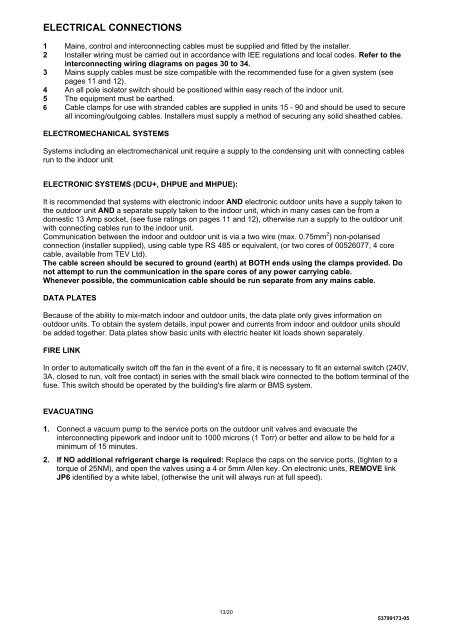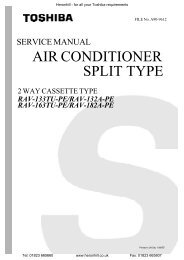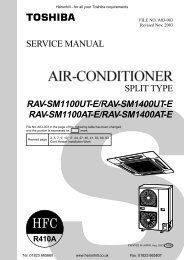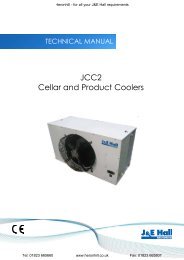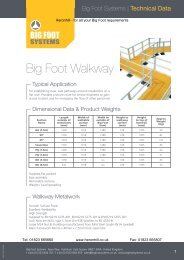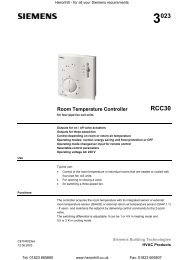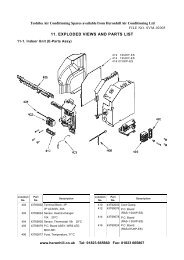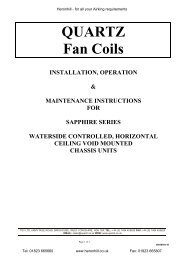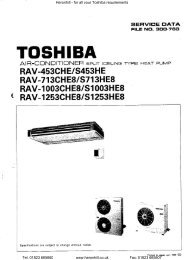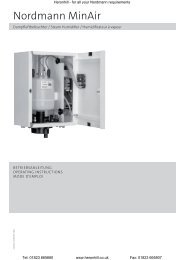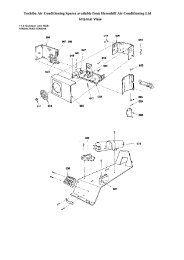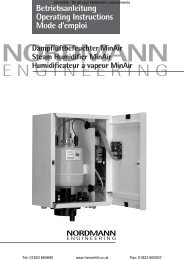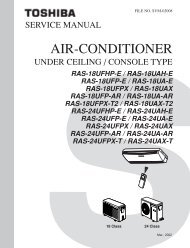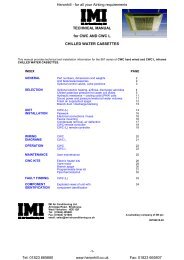impact / impact e wall mounted units technical manual - Heronhill Air ...
impact / impact e wall mounted units technical manual - Heronhill Air ...
impact / impact e wall mounted units technical manual - Heronhill Air ...
You also want an ePaper? Increase the reach of your titles
YUMPU automatically turns print PDFs into web optimized ePapers that Google loves.
ELECTRICAL CONNECTIONS<br />
1 Mains, control and interconnecting cables must be supplied and fitted by the installer.<br />
2 Installer wiring must be carried out in accordance with IEE regulations and local codes. Refer to the<br />
interconnecting wiring diagrams on pages 30 to 34.<br />
3 Mains supply cables must be size compatible with the recommended fuse for a given system (see<br />
pages 11 and 12).<br />
4 An all pole isolator switch should be positioned within easy reach of the indoor unit.<br />
5 The equipment must be earthed.<br />
6 Cable clamps for use with stranded cables are supplied in <strong>units</strong> 15 - 90 and should be used to secure<br />
all incoming/outgoing cables. Installers must supply a method of securing any solid sheathed cables.<br />
ELECTROMECHANICAL SYSTEMS<br />
Systems including an electromechanical unit require a supply to the condensing unit with connecting cables<br />
run to the indoor unit<br />
ELECTRONIC SYSTEMS (DCU+, DHPUE and MHPUE):<br />
It is recommended that systems with electronic indoor AND electronic outdoor <strong>units</strong> have a supply taken to<br />
the outdoor unit AND a separate supply taken to the indoor unit, which in many cases can be from a<br />
domestic 13 Amp socket, (see fuse ratings on pages 11 and 12), otherwise run a supply to the outdoor unit<br />
with connecting cables run to the indoor unit.<br />
Communication between the indoor and outdoor unit is via a two wire (max. 0.75mm 2 ) non-polarised<br />
connection (installer supplied), using cable type RS 485 or equivalent, (or two cores of 00526077, 4 core<br />
cable, available from TEV Ltd).<br />
The cable screen should be secured to ground (earth) at BOTH ends using the clamps provided. Do<br />
not attempt to run the communication in the spare cores of any power carrying cable.<br />
Whenever possible, the communication cable should be run separate from any mains cable.<br />
DATA PLATES<br />
Because of the ability to mix-match indoor and outdoor <strong>units</strong>, the data plate only gives information on<br />
outdoor <strong>units</strong>. To obtain the system details, input power and currents from indoor and outdoor <strong>units</strong> should<br />
be added together. Data plates show basic <strong>units</strong> with electric heater kit loads shown separately.<br />
FIRE LINK<br />
In order to automatically switch off the fan in the event of a fire, it is necessary to fit an external switch (240V,<br />
3A, closed to run, volt free contact) in series with the small black wire connected to the bottom terminal of the<br />
fuse. This switch should be operated by the building's fire alarm or BMS system.<br />
EVACUATING<br />
1. Connect a vacuum pump to the service ports on the outdoor unit valves and evacuate the<br />
interconnecting pipework and indoor unit to 1000 microns (1 Torr) or better and allow to be held for a<br />
minimum of 15 minutes.<br />
2. If NO additional refrigerant charge is required: Replace the caps on the service ports, (tighten to a<br />
torque of 25NM), and open the valves using a 4 or 5mm Allen key. On electronic <strong>units</strong>, REMOVE link<br />
JP6 identified by a white label, (otherwise the unit will always run at full speed).<br />
13/20<br />
53799173-05


